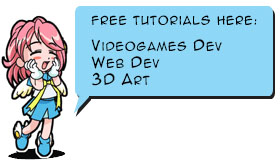Unity Game Engine – Stealth Game – Player Health – JS Script
Select the player object and assign:
PlayerHealth.js
#pragma strict
public var health : float = 100f; // How much health the player has left.
public var resetAfterDeathTime : float = 5f; // How much time from the player dying to the level reseting.
public var deathClip : AudioClip; // The sound effect of the player dying.
private var anim : Animator; // Reference to the animator component.
private var playerMovement : PlayerMovement; // Reference to the player movement script.
private var hash : HashIDs; // Reference to the HashIDs.
private var sceneFadeInOut : SceneFadeInOut; // Reference to the SceneFadeInOut script.
private var lastPlayerSighting : LastPlayerSighting; // Reference to the LastPlayerSighting script.
private var timer : float; // A timer for counting to the reset of the level once the player is dead.
private var playerDead : boolean; // A bool to show if the player is dead or not.
function Awake ()
{
// Setting up the references.
anim = GetComponent(Animator);
playerMovement = GetComponent(PlayerMovement);
hash = GameObject.FindGameObjectWithTag(Tags.gameController).GetComponent(HashIDs);
sceneFadeInOut = GameObject.FindGameObjectWithTag(Tags.fader).GetComponent(SceneFadeInOut);
lastPlayerSighting = GameObject.FindGameObjectWithTag(Tags.gameController).GetComponent(LastPlayerSighting);
}
function Update ()
{
// If health is less than or equal to 0...
if(health <= 0f)
{
// ... and if the player is not yet dead...
if(!playerDead)
// ... call the PlayerDying function.
PlayerDying();
else
{
// Otherwise, if the player is dead, call the PlayerDead and LevelReset functions.
PlayerDead();
LevelReset();
}
}
}
function PlayerDying ()
{
// The player is now dead.
playerDead = true;
// Set the animator's dead parameter to true also.
anim.SetBool(hash.deadBool, playerDead);
// Play the dying sound effect at the player's location.
AudioSource.PlayClipAtPoint(deathClip, transform.position);
}
function PlayerDead ()
{
// If the player is in the dying state then reset the dead parameter.
if(anim.GetCurrentAnimatorStateInfo(0).nameHash == hash.dyingState)
anim.SetBool(hash.deadBool, false);
// Disable the movement.
anim.SetFloat(hash.speedFloat, 0f);
playerMovement.enabled = false;
// Reset the player sighting to turn off the alarms.
lastPlayerSighting.position = lastPlayerSighting.resetPosition;
// Stop the footsteps playing.
audio.Stop();
}
function LevelReset ()
{
// Increment the timer.
timer += Time.deltaTime;
//If the timer is greater than or equal to the time before the level resets...
if(timer >= resetAfterDeathTime)
// ... reset the level.
sceneFadeInOut.EndScene();
}
public function TakeDamage (amount : float)
{
// Decrement the player's health by amount.
health -= amount;
}



